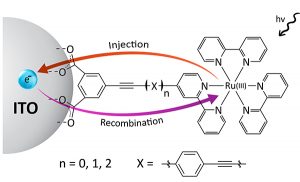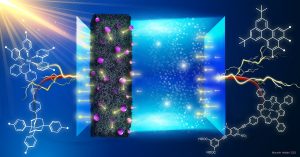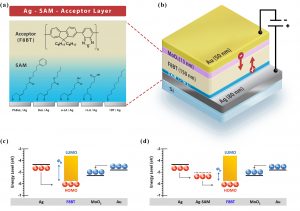Projects
My synthetic group designs and studies rigid molecular linkers for the functionalization of semiconductor nanoparticles (TiO2, ZrO2, and ZnO) with dyes, chromophores, and redox-active groups.
The systems that we are investigating range from simple molecules to complex supramolecular assemblies.
The nanoparticle-linker-donor systems allow fundamental studies of dye-nanoparticle electronic interactions as well as more practical applications for photovoltaics (solar cells), sensors, and other devices.
Projects:
Functionally active linker design for photoactive molecules at semiconductor interfaces (current). We use molecular design of linker units to control the chemical modification of nanostructured metal oxide semiconductor surfaces for the study of heterogeneous photochemical processes.
Directing molecular assemblies into covalently bonded 2D organic materials (current). We design organic molecules for on-surface synthesis on single crystal metals to direct the regio- and chemoselective formation of intermolecular C-C bonds and create highly-ordered 2D organics.
Bifunctional Complexes Bridging Nanocatalysts and Nanoparticles. Bifunctional chromophores able to tether two different type of nanoparticles (semiconducting and metallic) are synthesized to explore new approach to catalyze dye regeneration in dye sensitized solar cells.
Host-Guest Chemistry at Interfaces. Chromophoric or redox guests are encapsulated into molecular hosts, and the complexes are then bound to semiconductor surfaces, leading to improved stability and enhanced photophysical properties.
Zinc Oxide Nanorod Sensors. Step-wise click methods are a useful approach to bind reproducibly organic sensing layers onto ZnO nanorod sensors, leading to highly selective interfacial chemistry.


